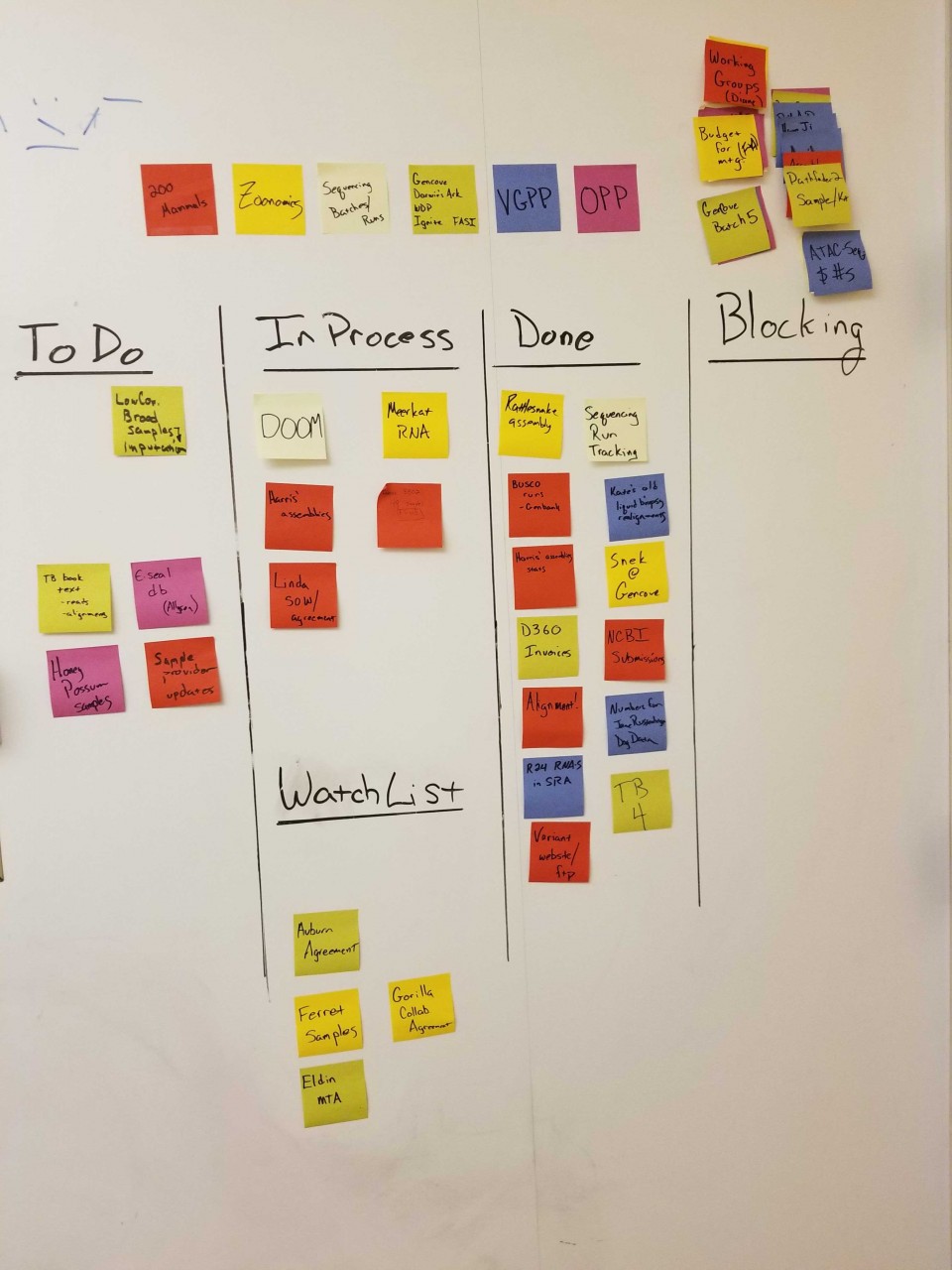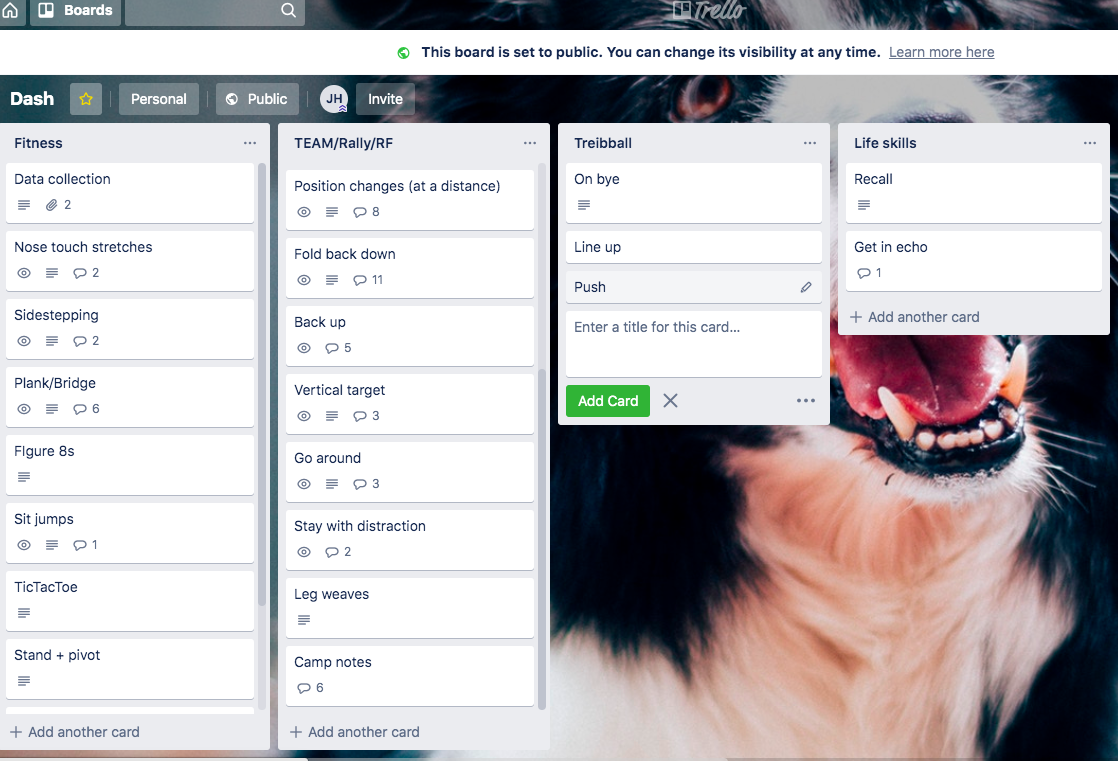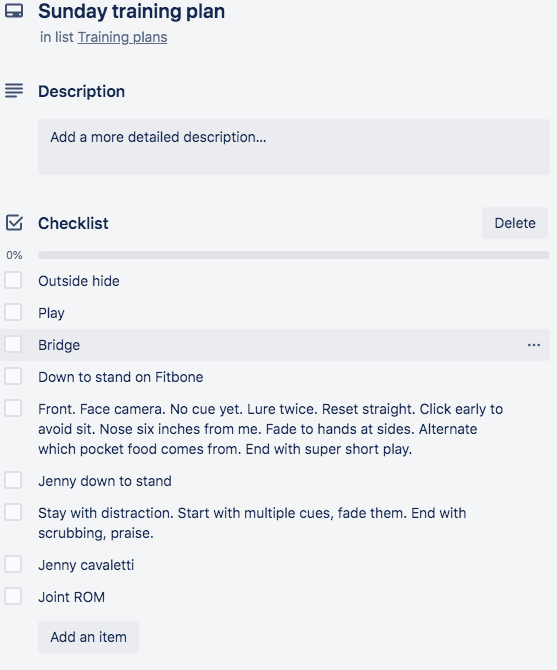Keeping Track of Training: How to Organize and Track Dog Training Plans with Trello
I want to:
- Keep track of where he is on each skill
- Keep all the information I've collected on different approaches to training that skill (from classes, webinars, books, in-person training with instructors, and my own experience with him)
- Not ignore the forest for the trees - remember where we're headed and prioritize what needs worked on next
- Make a training plan for a single day so I know which skills I'm working on that day and what I'm doing next with each (shaping, luring? criteria? how am I reinforcing?)
I've tried notebooks, and keeping a bullet journal worked great for a while.
But I really wanted to have all the information about each skill in one place. That's awkward to do on paper, where it's hard to keep inserting text "in the middle" of the journal instead of at the end. I also wanted quick links to online resources.
So I started looking for a digital app to do this for me.
Introducing Trello: What Is It? How Do I Use It For Dog Training?
What I'm using right now is Trello, one of the more widely used organizational apps. It's quite flexible, and I use it to manage my dog training in a bunch of different ways.
Trello has the concepts of boards, lists, and cards. If you had a desk with piles of paper on it, a "board" would be the desk, a "list" would be a pile of paper, and a "card" would be a single piece of paper. If you worked in different offices, you might have a bunch of different desks, and, similarly, you may have a bunch of different Trello boards.
Trello's interface is modeled after a personal kanban board, where a single board has columns (lists) of sticky notes (cards). My co-worker Jeremy has a gorgeous one to manage his work projects which he kindly agreed to let me photograph for you.
Trello is a "virtual board," similar to Jeremy's example.
It can be installed on an iPhone or an Android, and also used directly on the web (for those times when you want a keyboard to type in a lot of text).There are a lot of different possible approaches to organizing your information on boards, lists, and cards.
Here's what's currently working for me:
- One board per dog
- One list per sport
- One card per skill
- Board for my personal stuff, including a list for daily training plans
- Board for "Dog Sports Content" to keep track of which online classes and webinars I have worked through, which I intend to work through, and where I am when I'm midway through watching an online video.
Getting Organized: How to Use Trello to Track Dog Training Skills
Dash's board looks like this today:
Notice that I have a list for each sport - fitness, TEAM, etc. I have the skills I care about under each sport.
When I went to mini-camp in New Hampshire (it was great!) and learned something new about how to teach fronts, I opened the "front" card under the "TEAM" list and added a comment with this new piece of information.
If I take a TEAM 1 class at gold (also highly recommended) and my instructor gives me a useful tip, I can copy and paste that into a comment.
If there is a particular lecture about fronts, I can add a link to it in a comment on the "Front" card.
If there is a video of me training Dash to do a front that I want to save, I can put a link to that in the "Front" card and the video will show up, playable inline.
If I consider myself and my dog done with a particular skill - perhaps just working on it periodically to keep it fluent - I move it to the bottom of the list, color it a particular color to indicate to myself that it's not one of the hot skills to work on right now (I like blue to indicate "deep freeze"), or I delete or archive it, so it doesn't show up on the list at all.
I've also tried keeping a separate list of "fluent skills" and moving fluent skills there. (You may then need to move it back out if you've neglected it for a while and realize it's no longer fluent.)
Creating Dog Training Plans with Trello
Before planning my next session with a particular skill, I will open up the card for that skill and read through it to make sure I remember everything I want to work on.
"Oh right! I was starting to fade the lure last time, and that was going well." "Look at what I learned at mini-camp last week - I have to remember to incorporate that."
Without this review, keeping myself on track was challenging, and I was forgetting a lot of what I'd intended to do.
Or, on my own board, I have a list of "Training plans," with one card per day of the week. These are highly dynamic. Instead of adding comments here, I keep a single list on each card with skills that I intend to work on that day, with a quick summary of what I'm doing with that skill.
It outlines a complete training session. For example:
This particular card starts with some Nosework, then reminds me to start my inside training session with play. Next is fitness work, then TEAM skills. If I need reminding, I will put my current criteria and reinforcers here, or anything else I need to remember.
Because Trello is on my phone, I can reference it during the session to make sure I'm on track and haven't forgotten what I had planned to do next.
I don't make comments on these daily training plan cards. I just keep the single list, and I edit it every time I use it.
So when it's time to plan today's training, I can open up the card for Wednesday and see what skills I worked on last week. I can read the cards for each of those skills (on each dog's individual board) and then edit the Wednesday training plan card to update it with what I intend to do today, making sure I've progressed. I can remove or add skills if I want to work on different ones this week.
To make sure I keep working on all the things I want to — without doing just TEAM because I'm taking that class, and neglecting Nosework — I can look over all my training plans for the week.
Do I have Nosework in there? I can make sure to work on that three days a week if I'm concentrating on TEAM right now, or more if I have a Nosework trial coming up and I want to make sure those skills are very fluent at the moment.
For those who are working on fewer skills at once, or who only have one sport, a more traditional kanban board like Jeremy's might work better: a list of skills you intend to work on in the future, a list of what you're working on at the moment, a list of skills you're blocked on (can't progress until you figure out a particular problem - maybe waiting to buy that next piece of equipment), and a list that are done (or are currently fluent).
You may want just one board for all your dogs. You may have a board per sport and a list per dog (instead of a board per dog and a list per sport, like I do).
My use of Trello is always changing - this is just what works for me right now. It's been very helpful to keep myself from becoming overwhelmed by the firehose of information that is FDSA.
We've been talking on the FDSA Planning and Organization for Dog Trainers group on Facebook about our different approaches to organization, and I'd love to hear either there or on the Fenzi Dog Sports Academy Alumni group about what you do.
By accepting you will be accessing a service provided by a third-party external to https://www.fenzidogsportsacademy.com/


